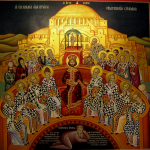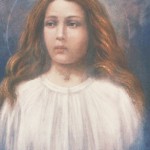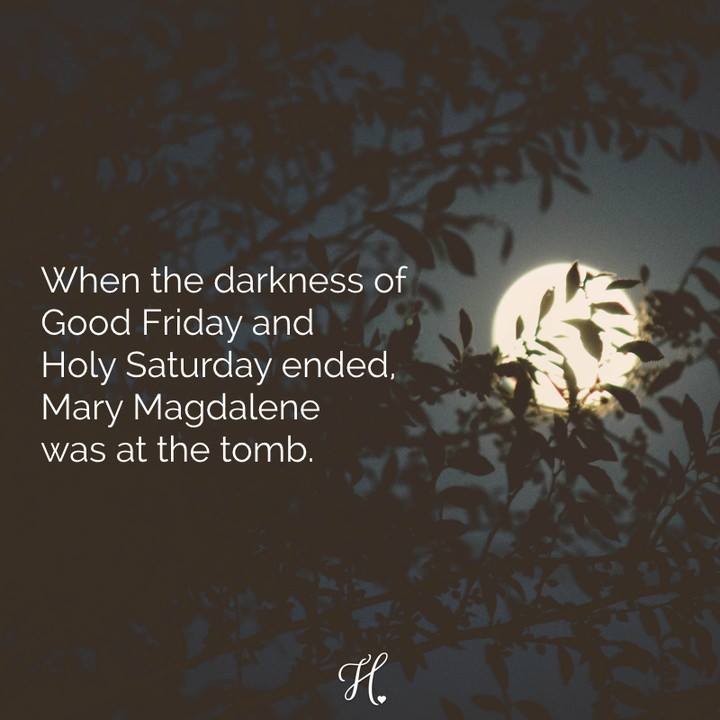Headcanon: (according to urbandictionary) “Used by followers of various media of entertainment, such as television shows, movies, books, etc. to note a particular belief which has not been used in the universe of whatever program or story they follow, but seems to make sense to that particular individual, and as such is adopted as a sort of “personal canon”. Headcanon may be upgraded to canon if it is incorporated into the program or story’s universe.”
Mary Magalene is a saint with a lot of different headcanons. Some see her as a prostitute, others think she was Jesus’s wife, Liz Curtis Higgs speculated that she was a wealthy independent woman (a rarity at the time) and my friend Sarah from college created a play that portrayed Mary Magdalene as a poet and Lazarus’s other sister. I have my own screenplay in the works called “The Longest Night In History” which portrays Mary Magdalene as an emotionally distraught woman who, in spite of her grief, is trying to keep the apostles from losing their tempers with each other.
But this headcanon, submitted anonymously to Catholic Teen Posts on Instagram (@catholic_teen_posts) takes the cake!
I think that—underneath centuries of Da Vinci Code style-conspiracy theories, being labeled a prostitute or a mystic, exalted above the disciples or placed beneath them, conflated with the other Marys or vilified in comparison with them or ignored entirely or reduced to an archetype, a symbol, something gold-leafed and enshrined or rebellion given flesh—underneath all that—I think she was just a Jewish woman.
She might have been married or not, wealthy or not, educated or not; she might have had children or sisters or brothers or run a business or been a beggar or none of the above. All we know—for a given value of “know”—is that Jesus expelled seven devils out of her (Luke 8:2) and that she was present at the crucifixion, burial, and resurrection (Matthew and Mark, and all four Gospels portray her as among the first to witness to the empty tomb and Jesus’s comeback tour.) Whenever Jesus’s female followers are listed, Mary Magdalene is at the head, which would at least seem to imply that she was prominent among them, in the same way that Peter is always listed first among the disciples.
I think she must have been fearless. A woman never described with any man in attendance; a woman who is listed first among women and who led them to the foot of the cross, to the tomb, who was unflinching witness in the face of Roman cruelty and oppression; a woman who had demons cast out from her (neuroatypical? epileptic?) and still did not choose “normal” life, but followed a prophet out into the wilderness—I can’t imagine how driven she must have been.
I like to think she and Peter got into fights because he was better with the day-to-day details of their journey and their finances, and she was all big picture, transcendence, the Kingdom of God, Petros, imagine it—and Jesus was sitting off to one side, massaging his feet and smiling faintly. I like to think that she played older sister to John, who had the same taste for the lofty and godly.
I like to think that the other women in Jesus’s retinue were a little afraid of her and her terrifying insight into the divine, but they also felt incredibly motherly towards her: “Magdalene, you forgot to eat at noontide, here, I brought you some stew; Magdalene, stop making excitable noises in Ya’akov’s direction and come to bed, you haven’t slept in two nights.”
I like to think that she was dry-eyed and furious at the foot of the cross, holding Jesus’s mother as this old woman (not old enough to lose a son) wept. I like to think she didn’t cry that night, when they were waiting for the mangled body to be taken down off the cross; or the next, when there were funeral preparations to make; or the next, when there were Shabbat rituals to carry out.
I like to think that when the resurrected savior announced himself to her on the third day, she slapped him. And when he protested that she never really believed him dead (because he basically spent forty days foreshadowing it, I mean, c’mon Miriam) she answered, “Well, maybe you shouldn’t scare me like that.” And that’s when she started crying.
I like to think that she was instrumental in the early church—the hand that rocks the cradle rules the world, and it isn’t as though the Twelve are welcome in spinning circles or standing around wells or in the kitchens where all real decisions are made. I like to think that she was there with Peter and James and John and Simon and all the disciples as they struggled to find the right words, to tell the story the right way, to follow in the footsteps of a man who had been God.
I like to think that when she became to old to wander, she had a house in Magdalene with her niece, who was her nurse and housekeeper. And the gate was always open and bread always on the table, candles lit for each of the Twelve who had been lost to them. I like to think that Christians came many miles to speak with her about Christ and the transcendence and how to be rescued from demons.
And her mouth was full of parables and her eyes lifted to God, and it was her small piece of the Kingdom, because Yeshua had promised it to her.
I can totally see Mary acting motherly to Magdalene, seeing her as the daughter she never had. Magdalene being everyone’s big sister and yet Jesus’s little sister, regardless of however old she was. One other thing from my screenplay came from something Diana Von Glahn said in the episode of The Faithful Traveler when she went to the Holy Land. It’s said that Jesus appeared to his mother first before appearing to Mary Magdalene. It’s never said in the Scriptures, but it’s interesting that Jesus’s own mother didn’t go with Magdalene to the tomb. So in my screenplay, I imagine what it would’ve been like.
Jesus appears quietly in the Upper Room and wakes his mother up. The two embrace but their talk is all pantomime. Jesus knows the dawn is coming soon, so he can’t stay long. He goes over to Mary Magdalene and fills her mind with a dream: a dream of the tomb opening, revealing the empty space within. Magdalene wakes up as the dawn rises and Jesus is nowhere to be found. She sees Mary, seemingly asleep, and gets ready to go to the tomb. In her hustle, she wakes Peter up and tells him, big sister that she is to him, to hold down the fort while she goes to the tomb with her friends. When Jesus appears to Mary Magdalene, she hugs him. She returns to the Upper Room screaming with joy and surprise and the rest, you can say, is history.












